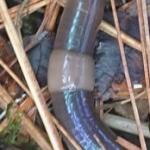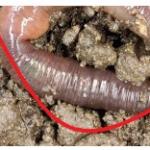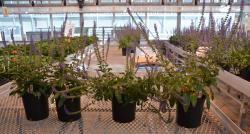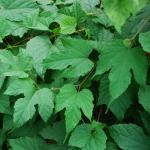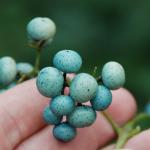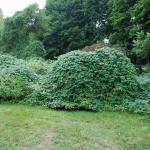A monthly e-newsletter from UMass Extension for landscapers, arborists, and other Green Industry professionals, including monthly tips for home gardeners.
To read individual sections of the message, click on the section headings below to expand the content:
Hot Topics
UMass Extension’s Tick and Mosquito Education Days are coming! And so is peak tick and mosquito season in Massachusetts…
This 2-day virtual webinar series will call upon topic experts to provide information about the seasonality, biology, and the diseases these organisms vector, as well as how to manage these pests and steps you can take to protect yourself.
Recommended for landscape and turf professionals, arborists, tree wardens, urban foresters, foresters, land managers, and any professionals or individuals working outside as well as public health officials and property owners in Massachusetts.
Tuesday, June 8: TICK TOPICS, 10:00 am – 12:10 pm
- Tick Management in the Landscape
- The Outreach Hiker’s Guide to Tick-ology: Personal tick bite prevention and more!
Tuesday, June 15: MOSQUITO TOPICS, 10:00 am – 12:10 pm
- Mosquitoes in Massachusetts, Arboviruses and Protecting Yourself
- Dealing With the Asian Tiger Mosquito: Incorporating an Invasive Species into an Existing Mosquito Control Program
For more details, the full schedule, and registration info, go to: https://ag.umass.edu/landscape/events/tick-mosquito-education-days.
Not All Worms are “Crazy”!
The warm temperatures and recent rains brought worms to the surface, sometimes in large numbers. For several years now, the jumping or crazy worms (Amynthas spp.) have become a common occurrence in many locations in Massachusetts. How can you determine what species of worms dominate in a particular area and is there any reason to be alarmed?
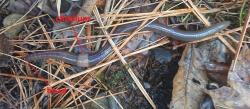 Most likely the worms that are found during the spring are NOT Amynthas spp. The adults of jumping or crazy worms (Amynthas spp.) cannot survive the winter in New England and require relatively worm soil temperatures to start developing from cocoons into adults. Cocoons and new hatchlings are not easy to spot. Adults become present in mid-summer and the peak of their abundance usually occurs in August – September. Accurate identification of an earthworm to species is only possible if an adult is collected. The shape, color and position of the clitellum are important for proper identification (Figure 1).
Most likely the worms that are found during the spring are NOT Amynthas spp. The adults of jumping or crazy worms (Amynthas spp.) cannot survive the winter in New England and require relatively worm soil temperatures to start developing from cocoons into adults. Cocoons and new hatchlings are not easy to spot. Adults become present in mid-summer and the peak of their abundance usually occurs in August – September. Accurate identification of an earthworm to species is only possible if an adult is collected. The shape, color and position of the clitellum are important for proper identification (Figure 1).
| characteristic |
JUMPING/“Crazy” worms |
NOT JUMPING/“crazy” worms |
|---|---|---|
| Overall color of the body | Entire body has a pigmentation, usually dark in color (brownish, greyish). | At least some parts are pale; night crawlers might have a dark-colored head and upper/dorsal part of the body, but the underside and tails are light colored; entire body of some species is pale. |
| Clitellum color |
Distinctly white or much lighter than color of the body. |
Somewhat similar to color of the body. |
| Clitellum type |
Annular clitellum, encircling the worm’s body. |
Saddle-like clitellum, very distinct on the upper side, flattens on the underside. |
| Position of the clitellum |
Clitellum close to the head. |
Clitellum farther away from the head. |
| Movement | Snake-like movement, thrashing S-patterned movement. |
Slower, move by stretching the body segments and pulling the rest of the body to the head; some species might coil when disturbed, nightcrawlers flatten the tail. |
| Soil characteristics | Coffee grounds or like “Nerd©” candy in appearance. | |
| Seasonality/ Peak of adult activity | Most adults are observed in August - September. | Adults are active in early spring and the fall. |
What can be done
No product is labeled for control of earthworms and no effective methods to reduce these earthworm numbers are currently available. The most effective strategy is to minimize their spread. This time of the year (May), the cocoons and early hatchlings are virtually undetectable or identifiable. Extra care needs to be taken if Amynthas spp. was detected in the area earlier and if buying mulch, compost and plants for spring gardening.
Several considerations that might help reduce the risk of dispersal
- Mulch and compost are very common dispersal substrates; therefore, use a certified distributer, making sure that the mix is heated before distribution. Heat kills both cocoons and living worms.
- If plants are shared and a jumping worm infestation is suspected, bare root planting or washing the roots before sharing might help reduce the risk of spread.
- Do not release into the wild worms bought as fishing bait or for vermicomposting. Some sources have jumping worms among other species. Amynthas spp. should not be used for vermiculture.
Research Update
Potential for Reduced Irrigation and Fertilizer Application in Herbaceous Perennial Production
Container plant production is input intensive with frequent irrigation and fertilizer applications. This is because the visual quality of plants is one of the most important factors to consumers. Frequent inputs of water and nutrients are provided to avoid negative growth impacts with under-application. However, over-irrigation and over-fertilization can also result in unfavorable growth such as leggy, floppy, or uneven growth. Reduced irrigation and fertilizer applications can also lessen the environmental impact of production, increasing sustainability. Another potential use of reduced irrigation is as a method of plant growth control in place of plant growth regulators or hand pruning.
Research in the Bayer lab at UMass Amherst is looking at the impact of reduced irrigation and fertilization on growth and flowering of herbaceous perennial species. The goal of the research is to gain a better understanding of herbaceous perennial water and nutrient requirements while also understanding how irrigation can be used to control plant growth. The research will also provide information on the potential for reducing the inputs needed for herbaceous perennial production.
In the first set of experiments, we looked at the effect of reduced irrigation on plant growth and the potential for alternating substrate volumetric water during production as a means of growth control. Irrigation was applied via a soil moisture sensor automated irrigation system to supply either a reduced irrigation treatment (20% or 25% water content) or a well-watered irrigation treatment (38% or 40% water content). For the alternating treatments, the reduced irrigation treatment was either applied during the first two weeks or final four weeks of production.
The response was species-specific, but there were some similarities. Flower number was not different for 'East Friesland' salvia or 'Pow Wow Wildberry' coneflower. ‘Mardi Gras’ sneezeweed had the greatest number of flowers at 40% water content, but all treatments produced an adequate number of flowers. Plant height was greatest for the well-watered plants for sneezeweed and the well-watered and alternating treatment ending with well-watered conditions coneflower. Salvia height was not different between treatments. Shoot dry weight of sneezeweed was also greatest for well-watered plants whereas the well-watered and alternating treatment ending with well-watered conditions the greatest shoot dry weight for salvia and shoot dry weight was unaffected by treatment for coneflower. Although the well-watered plants tended to be larger, the extra growth was not necessarily desirable. Salvia plants that received the alternating treatment with reduced irrigation first had an open, floppy habit that would impact the salability of the plants. This suggests that alternating irrigation during production of 'East Friesland' salvia from a lower volume to a higher volume can result in unfavorable, excessive plant growth. The well-watered sneezeweed were very large and less visually appealing, although not as floppy as the salvia receiving the reduced irrigation, well-watered alternating treatment. Plants receiving the reduced irrigation treatment were more visually appealing for all species even though they were smaller. Overall, the experiments showed that even though there was a species-specific response to reduced irrigation, there is still good potential for reducing irrigation applications. It was also noted that the more drought tolerant Echinacea was less impacted than the Helenium and Salvia.
In the second set of experiments, we looked at the impact of reduced irrigation and fertilizer rate on growth and flowering of 'Ruby Candle' beardtongue, 'Visions' astilbe, and 'Mellow Yellow' coneflower. A soil moisture sensor automated irrigation system was again used to maintain well-watered or reduced irrigation treatments. A controlled release fertilizer was applied at 100%, 50%, or 25% of the medium recommended bag rate (12 g/plant) for beardtongue and 50% or 100% for coneflower and astilbe. For beardtongue and astilbe, flowering was not affected by irrigation or fertilizer rate. For coneflower, there was a water content effect with well-watered plants having more flowers than the reduced irrigation plants. Average plant height of beardtongue was greatest for the 50% fertilizer rate but was not affected by irrigation treatment, whereas height of coneflower and astilbe were not different between treatments. Plant fresh weight of beardtongue was greater for well-watered than reduced irrigation plants and for the 100% fertilizer rate than the 25% fertilizer rate. Shoot dry weight of astilbe was greater for the well-watered treatment than the reduced irrigation treatment with no fertilizer rate effect. Coneflower shoot dry weight was not impacted by treatments. Although the results were again species-specific, for all species it was found that fertilizer applications could be reduced up to 50% while still producing salable plants. Although the low water content used in these studies for the reduced irrigation treatment (18% volumetric water content) was considered too low, a water content less than 40% could still produce salable plants.
Overall Conclusions
Reduced irrigation generally produced more compact, more visually appealing plants. The exuberant growth seen by the sneezeweed, salvia, and beardtongue receiving the well-watered treatments demonstrates the irregular growth that can be seen with excessive irrigation. Plant growth response to reduced fertilizer rates shows the potential for reductions in fertilizer applications up to 50% without negatively impacting growth. These results indicate the potential for reduced fertilizer and irrigation applications in perennial production. Reduced inputs have the potential to reduce fertilizer leaching and runoff. More compact plant growth will also be favorable for shipping, increasing the number of plants that can fit on a truck and decreasing the potential for plant damage due to branch breakage.
Additional information on this research can be found in:
Bayer, A. 2020. Effect of reduced irrigation on growth and flowering of coneflower and sneezeweed. HortTechnology. 30:315-321.
Bayer, A. 2020. Growth and flowering of Salvia nemorosa ‘Ostfrieland’ in response to reduced irrigation. J. Environ. Hort. 38:63-67.
Bayer, A. 2020. Fertilizer rate and substrate water content effect on growth and flowering of beardtongue. Horticulturae. 6:57.
Bayer, A., 2021. Astilbe and coneflower growth as affected by fertilizer rate and substrate volumetric water content. Horticulturae. 7:52.
Funding
This research was supported by the National Institute of Food and Agriculture; U.S. Department of Agriculture; the UMass Center for Agriculture, Food and the Environment; and the Stockbridge School of Agriculture at University of Massachusetts Amherst, under project number MAS00487. The contents are solely the responsibility of the authors and do not necessarily represent the official views of the USDA or NIFA. It was also supported by the University of Massachusetts Center for Agriculture, Food, and the Environment Summer Scholar Program.
Mandy Bayer, UMass Extension Assistant Professor of Sustainable Landscape Horticulture
Questions & Answers
Q. What is the best time to apply preventive grub control to lawn areas?
A. The answer is, it depends… on the control option that you choose.
The first line of defense against grubs is to maintain healthy, vigorous turf through effective and consistent cultural practices. Grubs, however, feed on roots which make up the foundation of the turf system, and sometimes cultural practices are not sufficient for eliminating the possibility of unacceptable damage when grub pressure is high and/or populations are large.
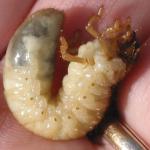 Turf-feeding grubs are the larvae of scarab beetles, and understanding their life cycle is critical for management. The general life cycle for scarab beetles in New England is as follows: adult beetles fly and mate in early summer (around the Fourth of July), and lay eggs shortly thereafter that hatch from July into August. Larvae (grubs) feed and grow into the fall and eventually move down in the soil to overwinter in that stage. In the spring, large grubs migrate back up in the soil profile and continue to feed before pupating in June to become adult beetles and complete the life cycle.
Turf-feeding grubs are the larvae of scarab beetles, and understanding their life cycle is critical for management. The general life cycle for scarab beetles in New England is as follows: adult beetles fly and mate in early summer (around the Fourth of July), and lay eggs shortly thereafter that hatch from July into August. Larvae (grubs) feed and grow into the fall and eventually move down in the soil to overwinter in that stage. In the spring, large grubs migrate back up in the soil profile and continue to feed before pupating in June to become adult beetles and complete the life cycle.
For preventive control to have the desired effect, the material should be in the root zone and active at the time when the grubs hatch. There are two principal categories of active ingredients currently available for preventive grub control that vary in this regard:
- A neonicotinoid material (imidacloprid, clothianidin, thiamethoxam… under several trade names) – these require no ‘activation period’ and are best applied at the time when egg hatch begins, in July. The use of neonicotinoids requires special considerations as pollinators are concerned: https://ag.umass.edu/turf/fact-sheets/neonicotinoid-turf-insecticides-pollinators. Please note also that neonicotinoids for outdoor applications will become restricted use materials in Massachusetts after July 1, 2022.
- Chlorantraniliprole (Acelepryn™ for commercial applicators, GrubEx™ for homeowners) – this material has an ‘activation period’, as it takes 60 to 90 days to fully dissipate in the soil for optimum effectiveness against grubs. Therefore, it is best applied in May in Massachusetts.
Regardless of the preventive approach selected, another pivotal consideration is to water-in the material effectively according to label directions to move it into the root zone where the grubs live -failure to water-in properly with irrigation or natural rainfall following application can dramatically reduce control.
Q. I’ve heard that turf has a role in combating climate change… how does that work?
A. The earth’s atmosphere behaves like a natural greenhouse, which plays a large role in enabling life on this planet. Heat from the sun is captured and radiated throughout the atmosphere owing to the presence of specific gases (water vapor, ozone, nitrous oxide, carbon dioxide, methane, etc), thereby warming the Earth’s surface and insulating us against the cold void of space. During the last few decades, there has been increasing concern that human activities are artificially accelerating this greenhouse effect and causing the earth’s surface to become too warm. When it comes to human activities contributing to potential climate change, carbon dioxide receives the lion’s share of attention.
Green plants have the ability to capture carbon dioxide from the atmosphere through the very important process of photosynthesis… carbon dioxide and water are combined in a reaction powered by light energy from the sun to produce carbohydrates. Photosynthesis is sometimes referred to as carbon fixation, and the period between carbon fixation and the point when the carbon is re-released to the atmosphere is called carbon storage. The longer that carbon is stored in the plant system, the greater the benefit in terms of reducing atmospheric carbon loads.
Carbohydrates produced by plants take two basic forms: non-structural and structural. Non-structural carbohydrates are free sugars used mostly to meet short term energy needs for growth and development. This route of carbon storage is largely temporary, in that carbon contained in non-structural carbohydrates is typically re-released after a short time. As plants are concerned, the real key in terms of cutting atmospheric carbon are the structural carbohydrates. Structural carbohydrates are a principal component of plant tissues, and some of these tissues are very resilient. The longer that structural carbohydrates stay intact, the longer that the carbon stored in them stays out of the atmosphere. Carbon can be stored in this way even after plants, or plant parts, die and become part of the soil. Carbon-containing organic material in the soil is often called soil organic carbon.
There is a lot of interest in both managed turf systems and natural grasslands when it comes to carbon fixation and storage because:
- These are very dense, often uniform communities of many, many plants, each of which are tiny carbon-fixing machines.
- Grasses are high turnover, which means they produce a lot of organic material that accumulates in the system and the soil and enables long-term carbon storage.
- Minimal disturbance defines most of these systems, which further enhances storage.
- Turf and grasslands are very common land features that cover significant area.
- Turf and grasslands have many other parallel functions, applications, and benefits in addition to fixing and storing carbon.
Some specific actions can increase the carbon fixation and storage capabilities of managed turf areas. Select Best Management Practices (BMPs) to this end, which often mirror and complement practices that help to meet other management objectives, are:
- Selecting grass species and cultivars best suited to the site and use – This lays the foundation for creating a dense, vigorous, and resilient turf, even before management inputs are considered. Research is also ongoing to identify grass species and cultivars that may be particularly adept at fixing and storing carbon relative to others.
- Maintaining healthy, dense turf cover; minimizing soil disturbance – The more healthy plants there are, the greater the overall photosynthetic capacity of the system, and the greater the overall carbon fixation. Short of necessary renovation or establishment, managing thatch, managing compaction, or overseeding to maintain density, soil disturbance should be minimized to avoid disrupting soil organic carbon stores.
- Irrigating to maintain active growth, where appropriate – with caveats, of course… in other words, irrigating to maintain active growth throughout the season promotes greater carbon fixation. However, many other factors go into irrigation, water management, and water conservation, so irrigation should be a part of the management program only where it is necessary and appropriate.
- Providing adequate and balanced nutrition, and returning clippings – Over-fertilization and associated excessive growth rates produce more succulent tissues that break down rapidly and are less effective at storing carbon. Returning clippings reduces the need for applied fertilizer and boosts organic matter turnover.
- Manage pests, as needed and as appropriate – Greater turf health and greater density translates to greater carbon fixation and storage… be sure to follow IPM principles.
- Reducing energy inputs – Turf has the potential to be a significant carbon “sink”, but several carbon-producing activities can go into the management of it. Actions that can help to ensure net benefit include maximizing mowing efficiency, maximizing height-of-cut according to the grasses present and the use of the turf, minimizing frequency-of-cut, the incorporation of ‘no-mow’ areas where applicable, and exploring the use of alternative fuel mowing equipment.
Jason D. Lanier, UMass Extension Turf Specialist
Trouble Maker of the Month
Porcelain-berry, Ampelopsis glandulosa var. brevipedunculata
Species overview
Recently renamed as Ampelopsis glandulosa var. brevipedunculata. Botanical synonyms include Ampelopsis brevipedunculata, Ampelopsis heterophylla var brevipedunculata, Ampelopsis heterophylla var amurensis, and Vitis brevipedunculata.
 Porcelain-berry, also known as Amur peppervine or peppervine is native to Asia and was introduced to the United States in the 1870s as an ornamental landscape plant. Porcelain-berry is considered invasive in Massachusetts and many other states. It is a deciduous, woody, perennial vine that is a vigorous invader of open and wooded habitats. Climbing vines form thick monocultures that overwhelm native trees, shrubs, grasses, and forbs, resulting in a reduction in species diversity and wildlife habitat. Porcelain-berry is tolerant of a wide range of soil types and conditions but thrives best in moist soils such as forest edges, riparian areas, and woodland openings. It prefers full to partial sun and is not tolerant of heavily shaded areas such as mature forests. Porcelain-berry is a member of the grape family (Vitaceae) - Virginia creeper, Parthenocissus quinquefolia, and wild grape,Vitis spp., are also in this plant family. Porcelain-berry, a non-native invasive, is commonly confused with our wild grape species, Vitis spp.
Porcelain-berry, also known as Amur peppervine or peppervine is native to Asia and was introduced to the United States in the 1870s as an ornamental landscape plant. Porcelain-berry is considered invasive in Massachusetts and many other states. It is a deciduous, woody, perennial vine that is a vigorous invader of open and wooded habitats. Climbing vines form thick monocultures that overwhelm native trees, shrubs, grasses, and forbs, resulting in a reduction in species diversity and wildlife habitat. Porcelain-berry is tolerant of a wide range of soil types and conditions but thrives best in moist soils such as forest edges, riparian areas, and woodland openings. It prefers full to partial sun and is not tolerant of heavily shaded areas such as mature forests. Porcelain-berry is a member of the grape family (Vitaceae) - Virginia creeper, Parthenocissus quinquefolia, and wild grape,Vitis spp., are also in this plant family. Porcelain-berry, a non-native invasive, is commonly confused with our wild grape species, Vitis spp.
Species description
Stems - Perennial, woody vines climb via non-adhesive tendrils that occur opposite the leaves. Vines commonly reach heights of 15 to 30 feet. New wood has small hairs. Bark has lenticels and does not naturally peel or shred. The bark of wild grape lacks lenticels and naturally peels or shreds as stems mature.
Leaves - Alternate leaves are dark green, somewhat glossy, 2 ½ to 5" long, coarsely-toothed with a heart-shaped base, and have 3 to 5 palmate lobes depending on their location on the stem. Leaves are shiny underneath with small hairs on veins.
Flowers and fruits - Flowers are inconspicuous, greenish-white flowers occurring in upward-facing cymes opposite the leaves from June through August. Fruits appear in September-October and are borne on long panicles. The fruit is a distinctive speckled berry, ranging in color from blue to pink, purple, and cream. Each berry holds 2-4 seeds.
Reproduction - Porcelain-berry spreads by seed (sexual) and through vegetative (asexual) means. Birds and other small animals are attracted to the fruit and spread the seeds. Seeds of porcelain-berry germinate readily to start new infestations. The taproot of porcelain-berry is large and vigorous and resprouting will occur in response to cutting of above-ground portions of porcelain-berry. Vegetative reproduction can occur when arching stems contact soil and root.
Management
- Hand-pulling/grubbing
- Most useful on small and/or new incursions. Attempts should be made to remove as much of, is not all, the roots as possible. Best done on immature plants that do not have the ability to flower and produce seed or before mature plants flower. Plant material can be stacked to dry and later composted.
- Herbicides
- Foliar treatment: Most appropriate when porcelain-berry grows as its sprawling, groundcover form rather than its tree-climbing form. Glyphosate or triclopyr are active on porcelain-berry. Applications provide the best control when applied in late summer. Triclopyr is a broadleaf herbicide and would be selected over glyphosate where grasses on the site need to be saved.
- Cut-stem or basal-bark treatment: Most appropriate for large populations that climb and overwhelm trees and taller vegetation. The herbicide triclopyr is the best choice for these strategies.
Randy Prostak, UMass Extension Weed Specialist
Garden Clippings Tips of the Month
May is the time to . . . .
-
Repot houseplants. As houseplants grow larger, they may outgrow their containers. When plant roots start to appear from the drainage holes or on the soil surface, it is time to repot. Other symptoms that indicate it is time to repot include: soil drying out quickly even during periods of cooler temperatures, lower leaves turning yellow, or the plant growing very slowly even when fertilized in the spring.
-
Harden off seedlings. As the weather starts to warm up, it's time to start preparing to transplant seedlings grown indoors out in the field or garden. Before transplanting outdoors, seedlings/transplants should be hardened off to prepare them for field conditions. If transplants are planted directly in the garden before they are adjusted to the sun, wind, rain and cool outdoor temperatures, they may not survive the shock. Transplants should slowly be exposed to the outdoor conditions so that they can slowly adjust to the harsh outdoor conditions. The process of hardening-off transplants may take 1-2 weeks depending on the weather and type of plant. Start by placing the transplants outside in a protected area out of direct sun, wind and rain for about 3-4 hours, and then increase the time the plants are outside while protecting them from strong sun, wind, hard rain and cold temperatures. If the weather forecast calls for temperatures below the crop’s minimum, bring the plants indoors or cover them with a blanket.
-
Plant cool season crops in the field. Early May is a good time to sow seeds of cool season crops such as spinach, beets, radish, carrots and lettuce. Seeds are sown thickly in rows and thinned later to the desired spacing to allow them to develop properly. Root crops such as carrots, beets, and radishes are thinned to a 2-inch spacing to allow the roots to develop properly. These are thinned as soon as they reach small edible size. Transplants are preferred for leafy vegetables such as kale and chard as they establish faster and mature early.
-
Monitor rhododendrons, azaleas, andromeda and mountain laurel for lace bugs. Look for injury that may show as small white or yellow stippling on the upper sides of leaves. On the underside of leaves, you may notice shiny, dark, varnish-like fecal drops of excrement and nymphs. There are 3-4 generations per year of this insect in New England and activity is from late-May into September. Horticultural oil or insecticidal soap work well when applied to the leaf undersides.
-
Preventative grub control application. May is good time to apply preventative grub control products containing chlorantraniliprole such as Acelepryn™ for commercial applicators or GrubEx™ for homeowners. These products have very low toxicity to vertebrates and no activity against bees, ants, or wasps, and are extremely effective against white grubs. For optimum effectiveness against grubs, these products should be applied early between mid-April and early June. After application, these products must be watered in according label directions.
-
Monitor for lily leaf beetles. The bright red lily leaf beetle (Lilioceris lilii) lay eggs and develop only on true lilies, Lilium spp. They begin to actively feed on the foliage as soon as lilies break through the ground in April to May. Adult beetles are about ½ inch long with a very bright red body and black legs, head, antennae, and undersurface. The adult beetles lay eggs on the undersides of leaves in May. The eggs are irregular-shaped and laid in rows that appear as tan-colored lines. The eggs hatch within 4-8 days into slug-like larvae. These larvae feed on leaves and, as they feed, they pile their own excrement on their backs, which makes them objectionable to hand-pick. If you only have a few plants in your garden, hand-picking adults and eggs can be effective.
-
Prune spring flowering shrubs. Spring flowering shrubs such as forsythia (Forsythia spp.), rhododendrons and azaleas (Rhododendron spp.), Virginia sweetspire (Itea virginica), mock orange (Philadelphus spp.), ninebark (Physocarpus opulifolius), spring blooming spirea (Spirea prunifolia and S. vanhouttei), lilacs (Syringa spp.) and viburnums (Viburnum spp.) should be pruned after bloom for maximum flower display. These shrubs form their flower buds the previous year on last season’s stem growth. Pruning these shrubs before bloom removes flowers buds and reduces the number of flowers in the current year.
-
Mulch around newly planted trees and shrubs. Organic mulches provide many benefits to newly planted trees and shrubs and other landscape plantings. The benefits of mulch include moisture retention, control of fluctuations in soil temperature, weed suppression, and prevents tree and shrub damage from lawn mowers. Organic mulch are attractive looking and also help with addition of organic matter to the soil through decomposition. Make sure you remove established perennial weeds before mulch is applied. Avoid mulch depths greater than 4 inches and do not allow mulch to contact the base of trees and shrubs.
-
Purchase plants from your local garden center. The month of May is the busiest month for garden centers and retail greenhouse operations in this region. During the month of May, they have a wide selection of plants and vegetable transplants. By purchasing plants from your local garden centers in May, you will get the best selection of plants and service and you will feel good about supporting local businesses.
Geoffrey Njue, UMass Extension Sustainable Landscapes Specialist
Periodical and Dog-day Cicadas in Massachusetts
 Cicadas are charismatic and loud insects that often draw public attention by massive emergences and loud noise. Recently, cicadas have been appearing in the news because of the expected emergence of the brood X (brood 10) in 15 states of the Eastern United States this spring (Figure1). Even though the 2021 emergence will not occur in Massachusetts, cicadas are potentially damaging and common insects in landscapes. In addition, the periodical cicada brood XIV (brood 14) occurs in Plymouth and Barnstable counties, according to observations in 2008. The emergence of brood XIV is expected in Massachusetts in 2025.
Cicadas are charismatic and loud insects that often draw public attention by massive emergences and loud noise. Recently, cicadas have been appearing in the news because of the expected emergence of the brood X (brood 10) in 15 states of the Eastern United States this spring (Figure1). Even though the 2021 emergence will not occur in Massachusetts, cicadas are potentially damaging and common insects in landscapes. In addition, the periodical cicada brood XIV (brood 14) occurs in Plymouth and Barnstable counties, according to observations in 2008. The emergence of brood XIV is expected in Massachusetts in 2025.
What are cicadas?
Cicadas belong to the order Hemiptera, known as “true bugs”. About 3,000 species of cicada have been described worldwide and approximately 170 species were recorded in the United States and Canada. Cicadas are commonly divided into three groups based on their life cycle and emergence patterns: annual or dog-day cicadas (Megatibicen spp., and Neotibicen spp.), periodical (Magicicada spp.) and proto-periodical cicadas (Okagana rimosa) (Fitzgerald 2016). The annual cicadas emerge every one or two years, and they are common but not very abundant. The periodical cicadas have a synchronized emergence and emerge in great numbers every 13 or 17 years. The proto-periodical cicadas sporadically occur in large numbers, but they are a rare occurrence in all other years.
General description and life cycle
Cicadas are large insects (size varies depending on species, generally 1.5 -2”). They have very distinct "bulging" eyes and four clear wings held roof-like over their body. Immatures (nymphs) resemble adults, but are smaller in size and do not have wings. Nymphs have strong front legs adapted for digging and making tunnels underground. Both adults and nymphs have beak-like, piercing-sucking mouthparts (stylets). Cicadas insert their stylets into the plant tissue and feed on the xylem (nymphs feed on roots and adults feed on the branches).
Cicadas spend most of their life span as nymphs (immatures) living and feeding underground. Nymphs go through five instars. When growth and development are completed, they emerge from the ground, usually after sunset. They crawl up trees, shrubs, poles or building walls, and molt into adults, leaving the old shed skin (exuvia) attached to the surface. Newly emerged adults are ready to fly by sunrise.
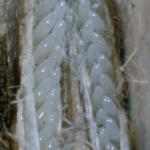 Adults live four to six weeks and their main purpose to disperse and reproduce. Males produce a loud noise to attract females for mating, usually calling to females from the tree tops. The song is unique for each species, which make is possible for the females to correctly recognize and locate a mate of the same species (Cooley and Marshal 2001). After mating, females make slits into the bark of young branches (1-2 year old, pencil-thick) with their saw-toothed ovipositor and lay the eggs (Figure 2). Eggs take about six to ten weeks to hatch and the emerging nymphs then drop to the ground and burrow into the soil where they spend most of their life.
Adults live four to six weeks and their main purpose to disperse and reproduce. Males produce a loud noise to attract females for mating, usually calling to females from the tree tops. The song is unique for each species, which make is possible for the females to correctly recognize and locate a mate of the same species (Cooley and Marshal 2001). After mating, females make slits into the bark of young branches (1-2 year old, pencil-thick) with their saw-toothed ovipositor and lay the eggs (Figure 2). Eggs take about six to ten weeks to hatch and the emerging nymphs then drop to the ground and burrow into the soil where they spend most of their life.
Periodical Cicadas
Periodical cicadas (genus Magicicada, includes 7 species) are native species and can be found only in the eastern North America (east of Rocky Mountains) (Cooley 2009). Periodical cicadas have long life cycles, emerging as adults every 13 or 17 years. Seventeen-year cicadas occur in the north, whereas 13-year cicadas are observed in the south with slight overlap. Periodical cicada species have very distinct geographical ranges with little overlap. The species occurring within this limited range (several states, as a rule) are referred to as a brood. Twelve 17-year broods and three 13-year broods occur in the United states (Liebhold at al. 2013). Roman numerals are used to name the broods. The developmental and emergence timing are nearly perfectly synchronized within each brood and usually do not overlap with other broods. Millions of adults emerge simultaneously with densities often reaching millions of cicadas per acre at any given location (Cooley et al. 2009). These mass emergences can be observed from mid- April to early June, triggered by an increase in soil temperature (65°F) and by significant rainfall (Fitzgerald 2016).
 During an emergence, millions of adults become active during the day and seemingly do not attempt to hide or camouflage themselves from predators. The male-produced mating call is very loud and conspicuous to predators. Adult coloration is quite bright and noticeable - they have a black body with red eyes and orange or red wing venations (Figure 3). In addition, periodical cicadas are slow and clumsy fliers, which makes them extremely vulnerable to predators (Oberdörster & Grant 2007). Apparently, this adaptive strategy satiates the predators and eliminates the need to avoid or escape them, allowing some portion of the cicada population to survive and produce offspring. The biomass of cicadas during an emergence can exceed 800 lb per acre and overwhelm predation (Williams 1995).
During an emergence, millions of adults become active during the day and seemingly do not attempt to hide or camouflage themselves from predators. The male-produced mating call is very loud and conspicuous to predators. Adult coloration is quite bright and noticeable - they have a black body with red eyes and orange or red wing venations (Figure 3). In addition, periodical cicadas are slow and clumsy fliers, which makes them extremely vulnerable to predators (Oberdörster & Grant 2007). Apparently, this adaptive strategy satiates the predators and eliminates the need to avoid or escape them, allowing some portion of the cicada population to survive and produce offspring. The biomass of cicadas during an emergence can exceed 800 lb per acre and overwhelm predation (Williams 1995).
Annual cicadas / Dog-day cicada
Several species (Megatibicen spp. and Neotibicen spp.) are commonly known as dog-day cicadas, annual cicadas or locusts. Annual cicada is a somewhat misleading name for these species. Even though they can be observed every year, their actual life cycle last for 2-4 years. Similarly, the name ‘locust’ refers to the large grasshopper species, so this common name is also not quite accurate for cicadas. The ‘dog-day’ name came from the observation that adult emergence for this group occurs at the time of the arrival of Sirius in the night sky, commonly known as the dog star.
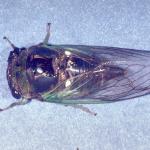 Adult annual cicadas (Figure 4) are larger than periodical (up to 2 1/4” long), are black green or olive-patterned, often having a whitish covering on their underside. Dog-day cicadas rely on strength, speed and camouflage to avoid predation, following quite a different survival strategy from periodical cicadas. Adults emerge later than periodical cicadas in late August – early September.
Adult annual cicadas (Figure 4) are larger than periodical (up to 2 1/4” long), are black green or olive-patterned, often having a whitish covering on their underside. Dog-day cicadas rely on strength, speed and camouflage to avoid predation, following quite a different survival strategy from periodical cicadas. Adults emerge later than periodical cicadas in late August – early September.
Hosts and damage
Adult and nymphs do not sting or bite, they do not carry diseases, and are not poisonous. Thus, they are harmless for humans and pets.
However, cicadas can feed on more than 200 species of woody plants, preferring oaks, flowering and fruit trees, mountain ash, and grapes. Potentially they can be harmful pests, most damaging to young, fruit bearing, and ornamental trees. Adult cicadas can damage plants during egg laying, causing alteration of branch architecture, reduced growth, and reduced fruit bearing. Prolonged nymphal feeding on xylem can reduce wood accumulation and flowering. In addition, mechanical damage caused by adults and nymphs can introduce pathogens (Reviewed by Williams 1995).
Most damage occurs during egg laying and can be prevented by covering plants with screens. Branches with cicada eggs can be pruned off to prevent future infestation and larval feeding. Insecticides usually are not recommended to control cicadas.
Researchers often stress the beneficial role of cicadas in the ecosystem. Nymphs aerate the soil by tunneling, especially during emergence. Adults serve as a food source for many other animals, and become a nitrogen source after they die off.
References
Cooley, J. R., G. Kritsky, M. J. Edwards, J. D. Zyla, D. C. Marshall, K. B. R. Hill, R. Krauss, and C. Simon. 2009. The Distribution of Periodical Cicada Brood X in 2004. The American Entomologist 55(2): 106-112.
Cooley, J. R., and D. C. Marshall. 2001. Sexual signaling in periodical cicadas, Magicicada spp. (Hemiptera:Cicadidae). Behaviour 138: 827–855.
Fitzgerald K. 2016. How do cicada know when to emerge from the ground. ESA Publication.
Grant PR. 2005. The priming of periodical cicada life cycles. Trends Ecol. Evol., 20: 169-74. doi: 10.1016/j.tree.2005.01.016. PMID: 16701364.
Liebhold, A. M., Bohne, M. J., and R. L. Lilja. 2013. Active Periodical Cicada Broods of the United States. USDA Forest Service Northern Research Station, Northeastern Area State and Private Forestry.
Oberdörster, U., and P. R. Grant. 2007. Predator foolhardiness and morphological evolution in 17-year cicadas (Magicicada spp.). Biological Journal of the Linnean Society 90:1–13.
Williams K. and C. Simon. 1995. The ecology, behavior and evolution of periodical cicadas. Annu. Rev. Entomol. 40: 269-95
To learn more about cicadas:
- Periodical Cicadas, UMass Extension fact sheet
- The 2021 Periodical Cicada Emergence (Brood X), UConn fact sheet
- Massachusetts Cicadas
- Cicada Mania
Olga Kostromytska, Extension Assistant Professor of Turf Entomology, UMass Amherst
Upcoming Events
For more details and registration options for any of these events, go to the UMass Extension Landscape, Nursery, and Urban Forestry Program Upcoming Events Page.
-
May 13 - Weedinar: Managing Japanese Knotweed
Credits: 1 pesticide contact hour for all private categories, 36, 37, 39, 40 and Applicators (core) license. Association credits: 1 MCLP, 1 MCA, 1 MCH, 1 ISA, and 1.5 SAF credits available. -
June 8 - Tick & Mosquito Education Day - Tick Topics
Credits: 2 pesticide contact hours for categories 29, 35, 36, 37, 48 and Applicators (core) license. Association credits: 1 education & 2 safety MCLP credits; 1 education & 2 safety MCA credits; 1 MCH credit; 2 ISA; and 2 (cat 2) SAF credits available. -
June 15 - Tick & Mosquito Education Day - Mosquito Topics
Credits: 2 pesticide contact hours for categories 29, 35, 36, 37, 46, 47, 48 and Applicators (core) license. Association credits: 1 education & 2 safety MCLP credits; 1 education & 2 safety MCA credits; 1 MCH credit; 2 ISA; and 2 (cat 2) SAF credits available.
Pesticide Exam Preparation and Recertification Courses
These workshops are currently being offered online. Contact Natalia Clifton at nclifton@umass.edu or go to https://www.umass.edu/pested for more info.
InsectXaminer!
Episodes so far featuring gypsy moth, lily leaf beetle, euonymus caterpillar, and imported willow leaf beetle can be found at: https://ag.umass.edu/landscape/education-events/insectxaminer
TickTalk with TickReport Webinars
To view recordings of past webinars in this series, go to: https://ag.umass.edu/landscape/education-events/ticktalk-with-tickreport-webinars
Additional Resources
For detailed reports on growing conditions and pest activity – Check out the Landscape Message
For professional turf managers - Check out our Turf Management Updates
For commercial growers of greenhouse crops and flowers - Check out the New England Greenhouse Update website
For home gardeners and garden retailers - Check out our home lawn and garden resources. UMass Extension also has a Twitter feed that provides timely, daily gardening tips, sunrise and sunset times to home gardeners at twitter.com/UMassGardenClip
Diagnostic Services
Landscape and Turf Problem Diagnostics - The UMass Plant Diagnostic Lab is accepting plant disease, insect pest and invasive plant/weed samples . By mail is preferred, but clients who would like to hand-deliver samples may do so by leaving them in the bin marked "Diagnostic Lab Samples" near the back door of French Hall (please note that visitors are not allowed inside the building). The lab serves commercial landscape contractors, turf managers, arborists, nurseries and other green industry professionals. It provides woody plant and turf disease analysis, woody plant and turf insect identification, turfgrass identification, weed identification, and offers a report of pest management strategies that are research based, economically sound and environmentally appropriate for the situation. Accurate diagnosis for a turf or landscape problem can often eliminate or reduce the need for pesticide use. See our website for instructions on sample submission and for a sample submission form at https://ag.umass.edu/services/plant-diagnostics-laboratory. Mail delivery services and staffing have been altered due to the pandemic, so please allow for some additional time for samples to arrive at the lab and undergo the diagnostic process.
Soil and Plant Nutrient Testing - The UMass Soil and Plant Nutrient Testing Lab is accepting orders for routine soil analysis and particle size analysis ONLY (please do not send orders for other types of analyses at this time). Send orders via USPS, UPS, FedEx or other private carrier (hand delivered orders cannot be accepted at this time). Processing time may be longer than usual since the lab is operating with reduced staff and staggered shifts. The lab provides test results and recommendations that lead to the wise and economical use of soils and soil amendments. For updates and order forms, visit the UMass Soil and Plant Nutrient Testing Laboratory web site.
Tick Testing - The UMass Center for Agriculture, Food, and the Environment provides a list of potential tick identification and testing options at: https://ag.umass.edu/resources/tick-testing-resources.
